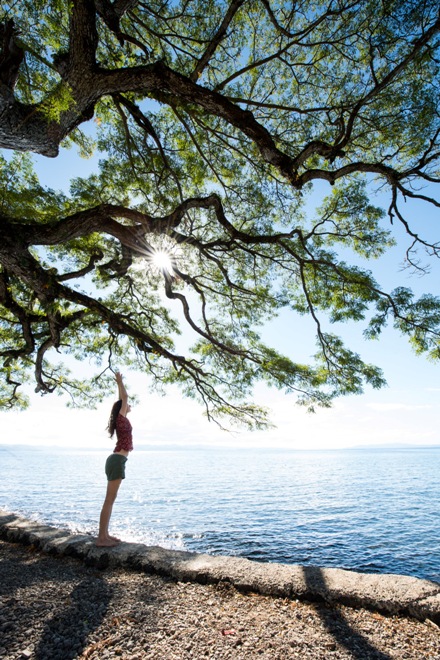I did a double take the first time my yoga teacher mentioned “patriarchy.”
Hold on, I thought.
We’re in a yoga class here, not in Gender Politics 101.
As he continued speaking, I realized he was using “patriarchy,” “misogyny,” and “masculine and feminine” in expansive ways to refer to the domination of the masculine principle over the feminine.
“Yoga,” he explained, “Brings the two into the perfect harmony in which they already exist in nature—from within an atom to in a flower.”
And to my surprise, I realized it showed the separate boxes we tend to put life into: the personal or the political, the “spiritual” or the worldly, the internal or the interpersonal, self-care or activism.
As our training continued, I saw that my teacher, Mark Whitwell, had had the courage to transform his own gender-programming as a New Zealand male into something gentle, positive, receptive, and beautiful: the masculine and feminine in tangible harmony, as it is in nature.
I asked him how he had done so, and he explained that it was through a real yoga practice—the union of opposites—as it was brought through from the Great Tradition by “the teacher of the teachers,” T. Krishnamacharya and his son T.K.V. Desikachar, and through meeting teachers who had resolved their own gender polarities.
He explained that this balance is already the case for each and every one of us, because we are part of nature. However, our mind often imagines something different, making a big mess.
And what is that faulty logic?
I felt how I and others had duplicated Western culture by prioritising and privileging strength, rationality, thinking, abstraction, overcoming, striving, and forcefulness (the masculine) over softness, tenderness, vulnerability, receptivity, and whole-body feeling (the feminine).
It’s not that any of these qualities are bad, just that valuing the first group over the latter made me really out of balance. Strength without receptivity is brittle and aggressive. This value system affects not just men, but women too—men are told they are purely masculine, and women they are purely feminine, and that the first is superior to the latter.
This means men are deprived of the receptivity necessary to be a decent, feeling human, and women carry the burden of being second-class citizens, the object to man’s subject. Men then try to access the feminine through “getting” women (whether violently or not), rather than coming into balance in themselves and then receiving a partner with tenderness and love.
This imbalance has obvious physical evidence: I noticed through teaching and watching Mark teach that almost everyone—particularly men—has a strong, forceful exhale, but a compromised inhale. We can be strong, but not receptive.
This lack of receptivity makes all kinds of problems in our lives that we associate with imbalanced masculinity: everything from trouble listening through to all kinds of violence. When we lack receptivity, we lose touch with our bodies, our lives, and the people around us, and relationships become difficult.
It feels only right that an authentic practice should have the power of radical social transformation, beyond just making us fitter or healthier or calmer as individuals.
With the majority of yoga teachers and students being women, where is the awareness of this deep level of gender inequality in the yoga world?
Are we just using yoga asana to play the old patriarchal game of woman as object, becoming more flexible and sexy to become the perfect object? Are we empowered as life itself, the power of the cosmos? Or are we “empowered” as we approximate an artificial ideal and feel more confident on that basis—an approach predicated on the superiority of some bodies over others?
I reflected on my first ever yoga class, an intense sweat-and-muscles-focused class that my boyfriend had taken me to in the hope I’d become more flexible.
There was no breath in that yoga, no merging of opposites, no teaching on the polarity of male and female.
I hesitate to call such physically-orientated classes yoga—not to deny that there are absolute physical and well-being benefits in the asana gymnastics popularized in the West, but if we limit our understanding of yoga to that, we’re going to miss out on the profound and life-changing potential this ancient technology actually offers.
I’ve seen seasoned yogis and yoginis stunned to realise what they’ve been missing out on when given the full picture of practice directly from the tradition. And this potential includes the power to address gender inequality, both within oneself and in the wider world.
My understanding of the imbalance between masculine and feminine made me reflect back on past relationships and understand the habits of previous boyfriends—ranging from dissociative to emotionally stunted to outright abusive—as expressions of toxic masculinity: the masculine divorced from the feminine.
I felt immense relief as I realized that contrary to patriarchy’s messages, it hadn’t been “all my fault” or a personal failure: that everyone is dealing with the same dumb social conditioning that makes us unable to feel ourselves and receive each other.
It has been painful and unpleasant to feel how my fairly average relationship experiences were actually filled with the results of toxic masculinity: controlling behaviour, objectification of my body by us both, very little attention to my own pleasure and desire. They were often pushy, hard, performative, porn-influenced, combined with humiliation and frustration.
We’re collectively coming to realise that “our normal is awful,” as blogger KatyKatiKate has movingly acknowledged. I realised that had the men in my life been given receptivity, they would have been able to feel the profound wonder and tenderness of their own embodiment, and wouldn’t have sought to “get” what they could not feel.
Why do we take it for granted that by the age of 15, men are less flexible than women? I look around where I am right now, in Bali, and see a loose elegance and feminine softness in the male bodies that are rare to see in the West. The men here haven’t been subjected to quite the same brutal conditioning to “man up” and not feel or emote. The bodies of Western men literally “harden up,” particularly through the sensitive areas of the chest and frontal line.
Real yoga is each person’s embrace of their own natural reality, the balance that is always already there in the body, despite the impositions of the mind and its social ideas.
In practical terms, that means simple breathing practices that help people feel better and feel better—two different sentences!
I’m coming to understand how profoundly mind and body are connected. The mind arises from the vast intelligence of the whole body. More and more people are coming to appreciate that our conditioning goes deep into our bodies—gendered and otherwise.
It’s not enough just to critically analyse the bad ideas we might have grown up with, although that can be useful to start with. We need ways to tangibly and actually feel ourselves as larger than those limited boxes we’ve all been put into, and I have discovered that yoga is that way.
I’m inspired to share in every possible way the power of real yoga to bring the neglected feminine back into our lived experience and social arrangements. Until I began to end the domination of the masculine over the feminine within, I was doomed to play out unequal relationships with guys, whether “mindfully” or not.
Embracing the union of opposites within my own body through yoga has naturally led to a beautiful, respectful, loving, and unproblematic relationship with another person: that’s how it works. Sexuality is totally transformed to the heart’s activity, the most basic activity of life.
First, we embrace our own body and breath, then we become more self-aware and loving and able to function in relationship with another, which is the context for profound healing and transformation.
Coming back into relationship with ourselves and all of life–ending the tyranny of the masculine over the feminine—is how we prevent toxic masculinity and its spectrum of abusive behaviours.
The polarity of relationship is what life’s all about, from the atom to the flowers.
Bonus: 5 Mindful Things to Do Each Morning.
Author: Rosalind Atkinson
Image: EndlesSmiles Photography (with permission)
Editor: Sara Kärpänen
Copy editor: Yoli Ramazzina









Read 1 comment and reply